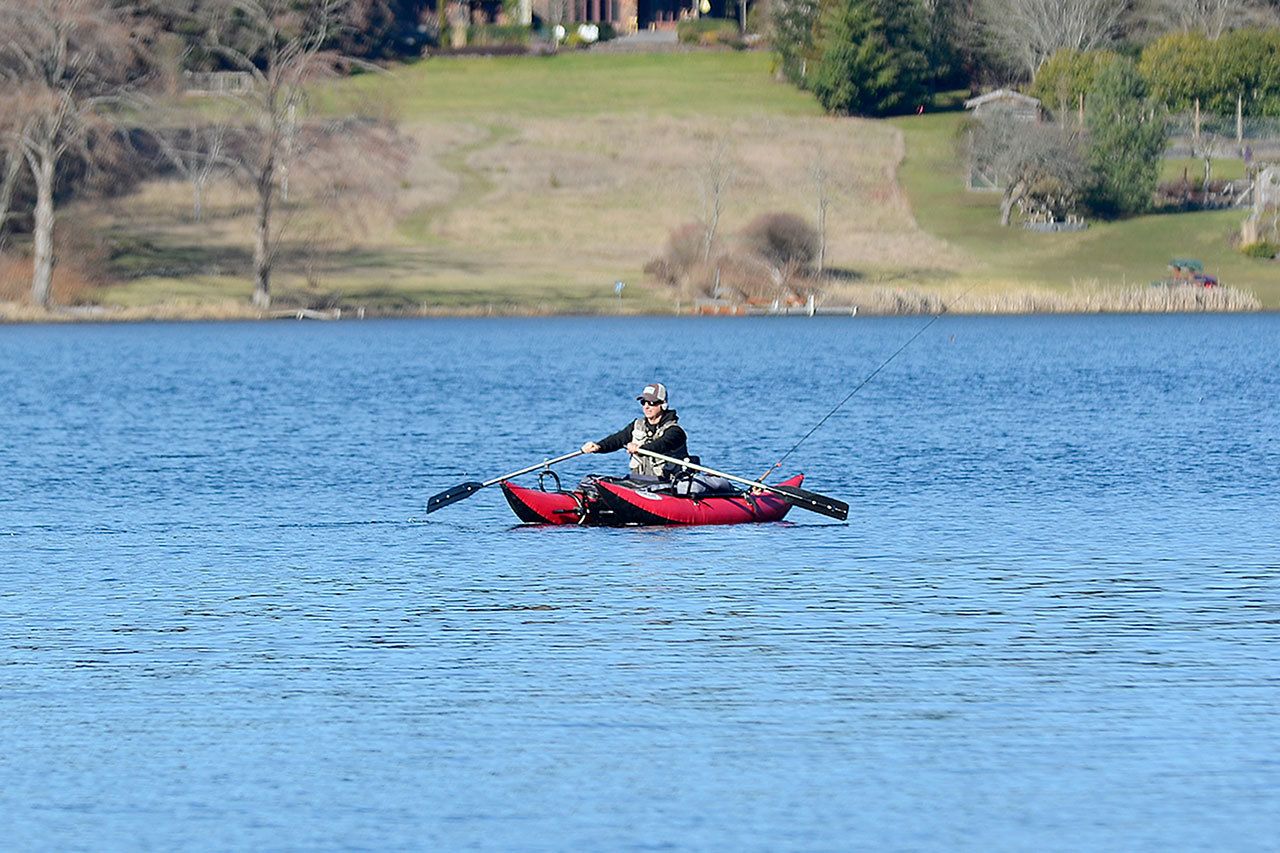Fishermen wielding bows and arrows will take to Lone Lake this April with a specific mission: Reduce the grass carp population.
Roughly 800 grass carp were introduced into the lake around eight years ago to keep Brazilian elodea, a noxious weed, in check. Well, the carp did their job. But, in an unforeseen turn of events, their presence has reduced submerged plant communities and increased algae bloom, which can negatively affect aquatic ecosystems. Now they’ve got to go.
The only trick is that they’re nearly impossible to catch, said Langley resident Clayton Wright of the Whidbey Fly Fishing Club. The carp only eat vegetation, cruise shallow waters and are easily spooked by fishermen.
“If you’re in a boat trying to catch them, you have to be perfectly still,” Wright said. “A little movement and they’re gone. That’s why guys don’t like to fish them. You can sit there for hours.”
Wright said when the carp were first introduced into the lake, they were about a foot long. They are now roughly 25 inches and have eaten “every bit of vegetation.”
“So far, everything has kind of failed,” said Wright, referencing the angler’s efforts to catch the fish. “We all tried to catch them and it’s almost a joke.”
Mukilteo resident John “Jake” Jacobson, a member of the Evergreen Fly Fishing Club’s Conservation Committee in Everett, said the bow fishermen will work the problem methodically.
“They’re going to bring their boats over with bigger platforms,” Jacobson said. “They’ll motor around the edge of the lake using lights and standing on the deck of the boat with a bow and arrow. They’ll shoot the carp in the water when they can see them.”
Local fishing clubs have made concerted efforts over the past few years to restore the lake to prime condition. One of those efforts will culminate in around two weeks when Lone Lake is stocked with 450 trout. A combined effort by five fishing clubs around Western Washington, including The Fishin’ Club of Whidbey Island and the Whidbey Fly Fishing Club, have raised $1,500 to stock Lone Lake with the trout. The fish, which will be coming from J &D Fisheries in Darrington within the next two weeks, will be around three years old, 13 or 14 inches long and meant for catch-and-release.
“We like to catch bigger fish, we don’t like to necessarily kill them,” Jacobson said. “The bigger fish fight hard. That is the joy of catching them. Then we like to turn them loose.”
In September, 1,000 dead rainbow trout visible on the shores of Lone Lake and perhaps even more beneath the water sparked concern among anglers who view the lake as a first-rate fishing location. The fish “die off” was mainly due to asphyxiation from low dissolved oxygen levels, while other factors included warm temperatures in the lake, an infestation of the noxious weed Brazilian elodea, algae blooms and the continued presence of grass carp that affects the water quality and exacerbates nutrient cycles in the lake, according to reports by Jacobson and Jerry Buron.
The lake is also eutrophic, meaning it has high levels of nitrogen and phosphorus.
“It’s going to take years to fix this,” Jacobson said. “It’s a slow process.”
Jacobson said the expertise of the Whidbey Conservation District and Island County staff may be called upon to address the water quality, and to develop a more rigorous monitoring system of the nutrient levels and water temperatures.
“These things, collectively, should make it better. We’re looking for a recovery of the fish population probably within a year,” Jacobson said.
The Washington Department of Fish and Wildlife typically stocks the lake with 3,000 fish per year, but they usually are around nine inches and weigh eight ounces. It was in October when the clubs pooled their resources together to address the shortage of fish.
“We’re talking about maybe 1,000 fishermen putting their resources together to do this,” Jacobson said.
The fish from J &D Fisheries will weigh a pound, providing anglers with a tougher catch throughout the year.
“It’s just going to be better fishing sooner,” said Wright, who also hopes the lake will be restored as a “robust fishery” by this fall.
EZ Rider, vice president of the The Fishin’ Club said the additional trout will help make the lake a yearlong fishing location.
“It’s great to see fisherman kind of rallying around this lake,” Rider said. “…This is a year-round freshwater lake that people can go to when they’re not able to go out to the beach for salmon fishing in the summer. That’s the big benefit that I see.”



